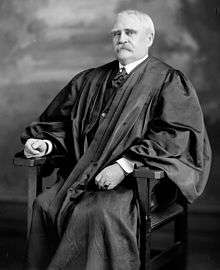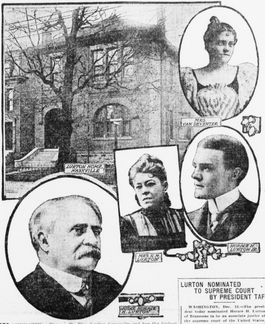Horace Harmon Lurton
Horace Harmon Lurton (February 26, 1844 – July 12, 1914) was an Associate Justice of the Supreme Court of the United States and previously was a United States Circuit Judge of the United States Court of Appeals for the Sixth Circuit and of the United States Circuit Courts for the Sixth Circuit. At age 65, Lurton was the oldest Justice to be appointed to the Supreme Court for the first time.
Horace Harmon Lurton | |
|---|---|
 | |
| Associate Justice of the Supreme Court of the United States | |
| In office December 20, 1909 – July 12, 1914 | |
| Appointed by | William Howard Taft |
| Preceded by | Rufus W. Peckham |
| Succeeded by | James Clark McReynolds |
| Judge of the United States Court of Appeals for the Sixth Circuit | |
| In office March 27, 1893 – December 20, 1909 | |
| Appointed by | Grover Cleveland |
| Preceded by | Howell Edmunds Jackson |
| Succeeded by | Loyal Edwin Knappen |
| Judge of the United States Circuit Courts for the Sixth Circuit | |
| In office March 27, 1893 – December 20, 1909 | |
| Appointed by | Grover Cleveland |
| Preceded by | Howell Edmunds Jackson |
| Succeeded by | Loyal Edwin Knappen |
| Personal details | |
| Born | Horace Harmon Lurton February 26, 1844 Newport, Kentucky |
| Died | July 12, 1914 (aged 70) Atlantic City, New Jersey |
| Cause of death | Heart attack |
| Resting place | Greenwood Cemetery, Clarksville, Tennessee |
| Political party | Democratic |
| Education | Old University of Chicago Cumberland School of Law (LL.B.) |
| Military service | |
| Allegiance | |
| Branch/service | |
| Years of service | 1861–1864 |
| Rank | First Lieutenant |
| Unit | |
| Battles/wars | American Civil War |

Education and career
Born on February 26, 1844, in Newport, Kentucky,[2] Lurton attended the Old University of Chicago,[note 1] then received a Bachelor of Laws in 1867 from Cumberland School of Law (then part of Cumberland University, now part of Samford University).[2] He served in the Confederate States Army as a Sergeant Major with the 5th Tennessee Infantry, 2nd Kentucky Infantry and 3rd Kentucky Cavalry from 1861 to 1865.[2] He entered private practice in Clarksville, Tennessee from 1867 to 1875.[2] He was Chancellor for the Tennessee Chancery Court for the Sixth Judicial District from 1875 to 1878.[2] He resumed private practice in Clarksville from 1878 to 1886.[2] He was a Justice of the Tennessee Supreme Court from 1886 to 1893.[2]
Civil War anecdote
Lurton was twice captured by Union forces, the second time sent as a prisoner of war to Johnson's Island Prison Camp in Sandusky Bay, Ohio. He claimed he was later paroled by President Lincoln because of pleas for mercy from his mother but this was merely an anecdote he often repeated to dinner guests, according to historian Roger Long. Mr. Long explains in detail what the evidence shows in an article he wrote in the December 1994 edition of Civil War Times. According to Mr. Long, apparently he was paroled from Johnson's Island only when he signed the oath of allegiance, not because of any act of the president. Mr Long's article includes interesting details about Lurton's service as well as possible reasons for the anecdote he was so fond of repeating.
Federal judicial service
Lurton was nominated by President Grover Cleveland on March 22, 1893, to a joint seat on the United States Court of Appeals for the Sixth Circuit and the United States Circuit Courts for the Sixth Circuit vacated by Judge Howell Edmunds Jackson.[2] He was confirmed by the United States Senate on March 27, 1893, and received his commission the same day.[2] His service terminated on December 20, 1909, due to his elevation to the Supreme Court.[2]
Lurton was nominated by President William Howard Taft on December 13, 1909, to an Associate Justice seat on the Supreme Court of the United States vacated by Associate Justice Rufus W. Peckham.[2] He was confirmed by the Senate on December 20, 1909, and received his commission the same day.[2] Appointed at the age of 65, Lurton was the oldest justice to be appointed to the Supreme Court for the first time.[note 2] He was Circuit Justice for the Second Circuit from January 10, 1910, until January 8, 1911, Circuit Justice for the Third Circuit from January 9, 1911, until March 17, 1912, and Circuit Justice for the Seventh Circuit from March 18, 1912, until July 12, 1914.[2] His service terminated on July 12, 1914, due to his death in Atlantic City, New Jersey.[2]
Other service
Concurrent with his service on the Sixth Circuit, Lurton served as Dean of the law department of Vanderbilt University from 1905 to 1909.[2]
Supreme Court appointment
In 1909, Lurton's friend, President William Howard Taft, named him to a seat on the Supreme Court that had been vacated by the death of Justice Rufus W. Peckham. It was the first of Taft's five Supreme Court appointments, six if one counts the elevation of Edward Douglass White to Chief Justice, and surprised some observers because unlike Taft, Lurton was a Democrat. Taft's attorney general George W. Wickersham said that at 66, Lurton was too old to become a Supreme Court justice, but Taft had always admired him. According to the Complete Book of U.S. Presidents (2001 edition), Taft later said that "the chief pleasure of my administration" was the appointment of Lurton.
Judicial philosophy
Lurton sided most frequently on the court with Associate Justice Oliver Wendell Holmes Jr.,[3] a progressive Supreme Court justice. The most notable opinion he authored was probably the opinion of the Court in Coyle v. Smith, 221 U.S. 559 (1911), which held that the federal government could not tell a state where to locate its capital, as that all states must be on "equal footing."
Death
Lurton's tenure on the Court was brief, as he served only four years before dying in Atlantic City, New Jersey of a heart attack on July 12, 1914. He is buried in Greenwood Cemetery in Clarksville, Tennessee.[4]
Legacy and honors
During World War II the Liberty ship SS Horace H. Lurton was built in Brunswick, Georgia, and named in his honor.[5]
Notes
- Lurton's Federal Judicial Center biography indicates he attended Douglas University, which actually was a pejorative term for the Old University of Chicago, stemming from Stephen Douglas's involvement with the institution.
- Charles Evans Hughes was two years older when appointed as Chief Justice by Herbert Hoover, but had served five years on the Court between the ages of forty-eight and fifty-three.
References
- "Compiled service records of Confederate Soldiers who served in organizations from the State of Kentucky". National Archives. Retrieved 25 February 2018.
- Horace Harmon Lurton at the Biographical Directory of Federal Judges, a public domain publication of the Federal Judicial Center.
- Randal Rust. "Horace Harmon Lurton".
- Young, Ed (March 1, 2018). "Horace Harmon Lurton". Tennessee Encyclopedia. Nashville, Tennessee: Tennessee Historical Society. Retrieved April 7, 2020.
- Williams, Greg H. (July 25, 2014). The Liberty Ships of World War II: A Record of the 2,710 Vessels and Their Builders, Operators and Namesakes, with a History of the Jeremiah O’Brien. McFarland. ISBN 1476617546. Retrieved December 9, 2017.
Further reading
- Irons, Peter. A People's History of the Supreme Court, p. 260. Penguin Books, 2000. Peter Irons wrote critically of Lurton's lack of impact on American Constitutional Law, even though Lurton only served on the High Court for four years before his death.
External links
| Wikimedia Commons has media related to Horace Harmon Lurton. |
- Horace Harmon Lurton at the Biographical Directory of Federal Judges, a public domain publication of the Federal Judicial Center.
- Horace Harmon Lurton at Find a Grave
| Legal offices | ||
|---|---|---|
| Preceded by Howell Edmunds Jackson |
Judge of the United States Circuit Courts for the Sixth Circuit 1893–1909 |
Succeeded by Loyal Edwin Knappen |
| Preceded by Howell Edmunds Jackson |
Judge of the United States Court of Appeals for the Sixth Circuit 1893–1909 |
Succeeded by Loyal Edwin Knappen |
| Preceded by Rufus W. Peckham |
Associate Justice of the Supreme Court of the United States 1909–1914 |
Succeeded by James Clark McReynolds |
